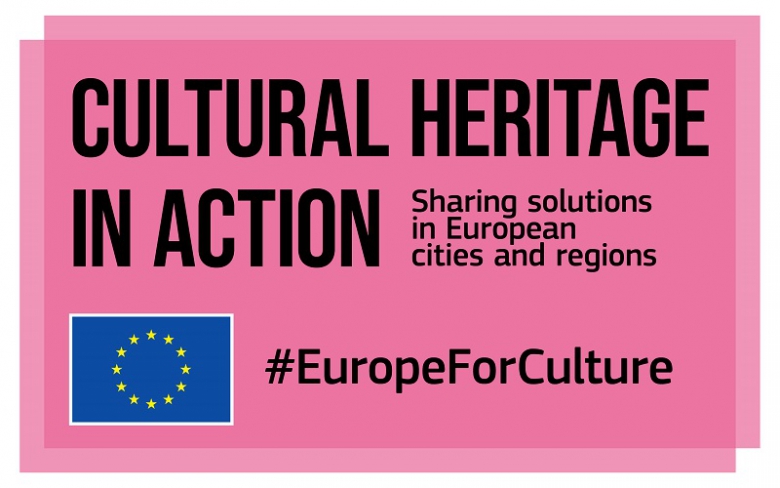Second “Sharing stories” webinar series on “Adaptive reuse of (industrial) buildings with a history”

Following the first successful episode of the “Sharing stories” webinar series, Europa Nostra, Architects’ Council of Europe and the Cultural Heritage in Action consortium are pleased to host the second episode on “Adaptive reuse of (industrial) buildings with a history” on 4 April from 14.00 to 15.30 CET.
Overview
Europe has a rich and multi-faceted built environment, incorporating strong spiritual, cultural, social and economic values. Due to evolutions in our economies and societies, many heritage sites, whether listed or not, are nowadays disused or have lost the functions for which they were originally built – notably industrial sites.
However, heritage buildings that have lost their original function still embody their multiple values. Adaptive re-use offers itself as a strategy aimed at preserving the elements that contain these values, while at the same time adapting the place for new uses and meeting needs of our time. Through smart renovation and transformation, heritage sites can find new, mixed or extended uses. As a result, their social, environmental and economic value is increased, while their cultural significance is enhanced.
Sensitive adaptive re-use of existing and historic buildings can also play a key role in Europe’s green transformation, avoiding energy-intensive new construction and land use, promoting waste-avoidance and preserving embodied energy while generating additional positive economic, environmental, social and cultural co-benefits. For this reason, the re-use of (industrial) heritage buildings offer many opportunities for advancing the goals of the New European Bauhaus initiative launched by the European Commission in 2020.
As illustrated by the first phase of the Cultural Heritage in Action project, which had this topic as one of the main focuses, the adaptive re-use of our built heritage brings multiple benefits to individuals and society, for present and future generations. Yet, it can still be regarded as being a unviable option, while planning and building regulations may prevent the development of re-use projects.
The webinar will give the opportunity to explore, through concrete examples, the benefits of re-using heritage sites; challenges inherent to adaptive re-use projects; drivers of quality interventions on cultural heritage.
Link to register: Teams / Link to connect: Teams
Case Studies
• Cukrarna’s Gallery (Ljubljana, Slovenia) is located in a building that was a sugar refinery in the XIXth century, before being used as a dwelling in the XXth century. The Cukrarna’s Gallery is now a cultural hub that serves both as a venue for exhibiting contemporary art and as a place where contemporary art projects of all kinds – visual, intermedia, performance, sound, music and more – can be created and presented. More information: https://cukrarna.art/en/
• KUMST creative hub (Brno, Czech Republic) is a functionalist building built in 1929 belonging to the University of Technology that was repurposed as a creative hub, which provides an environment for creative professionals to work, meet up, collaborate and educate themselves. More information: https://www.kumstbrno.cz/en/
• Galerías Va (Valladolid, Spain) is an old municipal market that was transformed into a space for work, creation and exchange. The space is available for people to develop a creative industry, an artistic project project individually or collectively, or participatory initiatives open to the community. This new place has contributed to the transformation of the neighbourhood, putting culture and creativity at the heart of local life. More information: www.info.valladolid.es/en/galerias-va
Themes and challenges to be discussed during the webinar
• Why is it important to re-use our built heritage, what are the benefits of re-using a heritage site, and what are the challenges inherent to such projects?
• How to preserve and enhance cultural, social and economic values of under-used heritage buildings, while at the same time adapting them to the needs of our time? What are the drivers for quality interventions on cultural heritage?
• How to involve citizens in deciding which heritage sites should be preserved, demolished or re-used, and how to work with them during the development of the project?
• What role and opportunities for cultural heritage in the New European Bauhaus?
Agenda
Webinar moderated by Lorena Aldana, European Policy Coordinator at Europa Nostra, and Pierre Obajtek, Senior Policy Officer at Architects’ Council of Europe
• General introduction to the webinar by Lorena Aldana, European Policy Coordinator at Europa Nostra (5’)
• Introduction to adaptive re-use in the European context by Ruth Schagemann, President of the Architects’ Council of Europe (7’)
• Presentation of Cukrarna’s Gallery in Ljubljana by Blaž Peršin, Director of Museums and Galleries of Ljubljana (10’)
• Presentation of KUMST creative hub in Brno by Zdeňka Hubáček Kujová, Director of Kumst, and Tomas Kozelsky, KOGAA Founding Partner
• Presentation of Galerías Va in Valladolid by Guillaume Rousseau, Technical adviser at City Council of Valladolid (10’)
• Main learning points, transferability tips and things to remember by Pierre Obajtek, Senior Policy Officer at Architects’ Council of Europe (5’)
• Q&A with the audience (15’)
• Conclusions and way forward by Jimmy Jamar, Head of the Europa Nostra Brussels office (7’)



